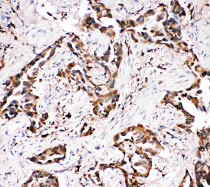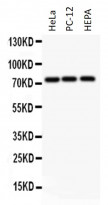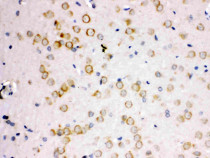ARG40373
anti-APLP1 antibody
anti-APLP1 antibody for IHC-Formalin-fixed paraffin-embedded sections,Western blot and Human,Mouse,Rat
Overview
| Product Description | Rabbit Polyclonal antibody recognizes APLP1 |
|---|---|
| Tested Reactivity | Hu, Ms, Rat |
| Predict Reactivity | Bov |
| Tested Application | IHC-P, WB |
| Host | Rabbit |
| Clonality | Polyclonal |
| Isotype | IgG |
| Target Name | APLP1 |
| Antigen Species | Human |
| Immunogen | Synthetic peptide corresponding to aa. 101-120 of Human APLP1. (ELQIARVEQATQAIPMERWC) |
| Conjugation | Un-conjugated |
| Alternate Names | APLP; Amyloid-like protein 1; APLP-1 |
Application Instructions
| Application Suggestion |
|
||||||
|---|---|---|---|---|---|---|---|
| Application Note | IHC-P: Antigen Retrieval: By heat mediation. * The dilutions indicate recommended starting dilutions and the optimal dilutions or concentrations should be determined by the scientist. |
||||||
| Observed Size | 72 kDa |
Properties
| Form | Liquid |
|---|---|
| Purification | Affinity purification with immunogen. |
| Buffer | 0.2% Na2HPO4, 0.9% NaCl, 0.05% Thimerosal, 0.05% Sodium azide and 5% BSA. |
| Preservative | 0.05% Thimerosal and 0.05% Sodium azide |
| Stabilizer | 5% BSA |
| Concentration | 0.5 mg/ml |
| Storage Instruction | For continuous use, store undiluted antibody at 2-8°C for up to a week. For long-term storage, aliquot and store at -20°C or below. Storage in frost free freezers is not recommended. Avoid repeated freeze/thaw cycles. Suggest spin the vial prior to opening. The antibody solution should be gently mixed before use. |
| Note | For laboratory research only, not for drug, diagnostic or other use. |
Bioinformation
| Database Links | |
|---|---|
| Gene Symbol | APLP1 |
| Gene Full Name | amyloid beta (A4) precursor-like protein 1 |
| Background | This gene encodes a member of the highly conserved amyloid precursor protein gene family. The encoded protein is a membrane-associated glycoprotein that is cleaved by secretases in a manner similar to amyloid beta A4 precursor protein cleavage. This cleavage liberates an intracellular cytoplasmic fragment that may act as a transcriptional activator. The encoded protein may also play a role in synaptic maturation during cortical development. Alternatively spliced transcript variants encoding different isoforms have been described. [provided by RefSeq, Jul 2008] |
| Function | May play a role in postsynaptic function. The C-terminal gamma-secretase processed fragment, ALID1, activates transcription activation through APBB1 (Fe65) binding (By similarity). Couples to JIP signal transduction through C-terminal binding. May interact with cellular G-protein signaling pathways. Can regulate neurite outgrowth through binding to components of the extracellular matrix such as heparin and collagen I. The gamma-CTF peptide, C30, is a potent enhancer of neuronal apoptosis. [UniProt] |
| Cellular Localization | Cell membrane; Single-pass type I membrane protein. C30: Cytoplasm. Note=C-terminally processed in the Golgi complex. [UniProt] |
| Calculated MW | 72 kDa |
| PTM | Proteolytically cleaved by caspases during neuronal apoptosis. Cleaved, in vitro, at Asp-620 by caspase-3 (By similarity). N- and O-glycosylated. O-glycosylation with core 1 or possibly core 8 glycans. Glycosylation on Ser-227 is the preferred site to Thr-228. [UniProt] |
Images (3) Click the Picture to Zoom In
-
ARG40373 anti-APLP1 antibody IHC-P image
Immunohistochemistry: Paraffin-embedded Human lung cancer tissue stained with ARG40373 anti-APLP1 antibody.
-
ARG40373 anti-APLP1 antibody WB image
Western blot: 40 µg of HeLa, PC-12 and HEPA whole cell lysates stained with ARG40373 anti-APLP1 antibody at 0.5 µg/ml dilution.
-
ARG40373 anti-APLP1 antibody IHC-P image
Immunohistochemistry: Paraffin-embedded Rat brain stained with ARG40373 anti-APLP1 antibody.








